The micro combined heat and power market is anticipated to expand from USD 1.4 billion in 2025 to USD 3.3 billion by 2035, demonstrating a robust CAGR of 9.0%. The market growth is largely driven by the increasing adoption of multiple technology platforms, each contributing uniquely to overall revenue generation.
Gas-fired micro-CHP systems are currently dominant due to their established infrastructure compatibility, high efficiency in residential and small commercial applications, and comparatively lower upfront costs. These systems account for a significant portion of annual market value, particularly in regions with mature natural gas networks and favorable regulatory support for distributed energy solutions.
Fuel cell-based micro-CHP units are emerging as a rapidly growing segment, supported by technological advancements, declining manufacturing costs, and enhanced efficiency in combined electricity and heat generation. Although still less widespread, fuel cell systems are projected to capture a larger share in later years of the forecast period, reflecting increased deployment in commercial buildings and high-end residential projects. The biomass-fueled micro-CHP units contribute a smaller yet notable fraction of the market, particularly in regions emphasizing renewable energy utilization and carbon reduction initiatives.
The market’s value composition demonstrates that gas-fired systems provide immediate revenue stability, while fuel cell and biomass technologies are expected to accelerate adoption, enhance technological diversity, and drive incremental growth. The interplay of these technology segments shapes investment priorities and strategic development within the Micro-CHP ecosystem, highlighting the significance of diversified technology contribution in sustaining long-term market expansion.
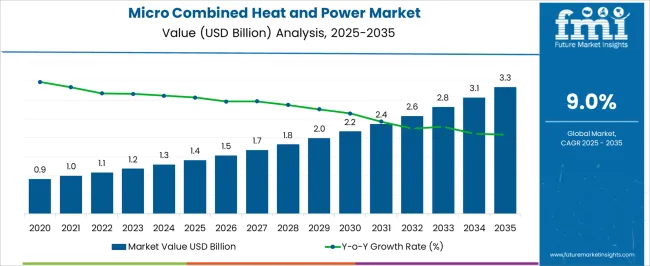
The micro combined heat and power market represents a specialized segment within the distributed energy and building energy systems industry, emphasizing on-site generation efficiency. Within the broader distributed energy solutions market, it accounts for about 6.1%, driven by growing adoption in residential and small commercial applications. In the combined heat and power equipment segment, it holds nearly 5.4%, reflecting its dual role in electricity and heat generation.
Across the microgeneration and decentralized energy systems market, the segment captures 4.7%, supporting demand for energy efficiency and reduced transmission losses. Within the smart building energy solutions category, it represents 3.9%, highlighting integration with energy management systems. In the renewable and low-carbon energy technologies sector, it secures 2.8%, showing its contribution to emissions reduction initiatives.
Recent developments in this market have focused on fuel flexibility, compact system design, and enhanced efficiency. Innovations include integration with natural gas, biogas, and hydrogen fuel sources, improving operational sustainability. Key players are investing in modular and plug-and-play units to simplify installation and maintenance for residential and commercial users.
Digital monitoring and remote control solutions have been implemented for predictive maintenance and optimized energy usage. Partnerships between equipment manufacturers and energy service providers are enhancing deployment in smart grid and district energy projects. The low-noise designs, improved CHP efficiencies, and incentives for low-carbon energy adoption are driving market growth. These advancements demonstrate how energy efficiency, technological integration, and sustainability considerations are shaping the micro combined heat and power market.
| Metric | Value |
|---|---|
| Micro Combined Heat and Power Market Estimated Value in (2025 E) | USD 1.4 billion |
| Micro Combined Heat and Power Market Forecast Value in (2035 F) | USD 3.3 billion |
| Forecast CAGR (2025 to 2035) | 9.0% |
The micro combined heat and power (micro-CHP) market is gaining momentum as decentralized energy solutions become integral to meeting efficiency, sustainability, and energy security targets. The current market scenario is shaped by rising demand from residential and small commercial applications, where the technology’s ability to simultaneously generate electricity and utilize waste heat offers significant energy cost savings and reduced carbon emissions.
Government incentives, feed-in tariffs, and stricter building efficiency codes are further supporting adoption across developed and emerging regions. Technological advancements in fuel flexibility, system integration, and digital monitoring are enhancing performance reliability and lowering operational costs, thereby widening the customer base.
While natural gas remains the dominant fuel, diversification into renewable-compatible systems is emerging as a long-term growth pathway. Over the forecast period, increasing electrification trends, energy price volatility, and the push for low-carbon infrastructure are expected to sustain market expansion, with strategic investments in product development and localized manufacturing driving competitive positioning and broader deployment.
The micro combined heat and power market is segmented by capacity, fuel, prime mover, application, and geographic regions. By capacity, the micro combined heat and power market is divided into 2kW, 2 kW to ≤ 10 kW, and > 10 kW to ≤ 50 kW. In terms of fuel, the micro combined heat and power market is classified into Natural Gas & LPG, Coal, Renewable Resources, Oil, and Others.
Based on the prime mover, the micro combined heat and power market is segmented into Internal Combustion Engine, Stirling Engine, Fuel Cell, and Others. By application, the micro combined heat and power market is segmented into Residential and Commercial. Regionally, the micro combined heat and power industry is classified into North America, Latin America, Western Europe, Eastern Europe, Balkan & Baltic Countries, Russia & Belarus, Central Asia, East Asia, South Asia & Pacific, and the Middle East & Africa.
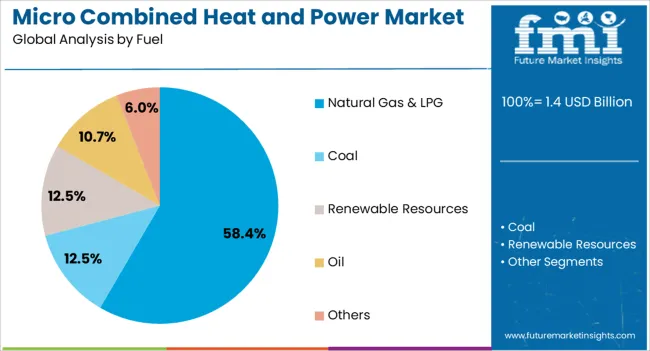
The natural gas & LPG segment, holding 58.40% of the fuel category, has maintained its lead due to the widespread availability of infrastructure and consistent pricing advantages compared to alternative fuels. This dominance is reinforced by the segment’s compatibility with existing gas grids, which minimizes installation barriers and accelerates adoption.
Operational efficiency and reduced emissions relative to oil-based fuels have strengthened its acceptance in markets with stringent environmental regulations. Supply chain reliability, supported by robust global production and distribution networks, has contributed to stable market penetration.
Furthermore, advancements in combustion technology and engine optimization have enhanced the performance of natural gas & LPG-powered systems, increasing their attractiveness for both residential and commercial users. Future growth potential will be supported by hybrid system integration with renewable energy sources, which could provide users with both flexibility and long-term energy cost stability.
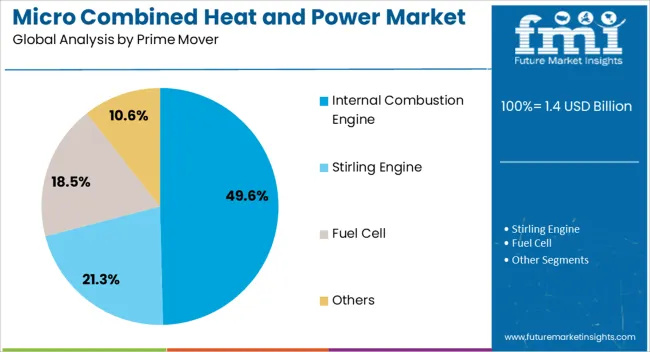
The internal combustion engine segment, representing 49.60% of the prime mover category, has retained its leading position due to its proven performance, scalability, and adaptability across varied operating conditions. Its market share is supported by decades of engineering refinement, which has yielded high reliability and low maintenance requirements in micro-CHP applications.
The segment benefits from lower upfront costs relative to emerging alternatives, making it accessible to a broader customer base. Compatibility with multiple fuel types, particularly natural gas and LPG, enhances its operational versatility and positions it as a preferred choice for grid-independent or backup power scenarios.
Continuous innovation in emissions control technologies and thermal efficiency improvements is bolstering compliance with environmental regulations, ensuring sustained relevance in both mature and emerging markets. Over the forecast horizon, further integration with digital monitoring solutions and predictive maintenance systems is expected to optimize lifecycle performance, reinforcing its competitive advantage in the micro-CHP market.
The market has witnessed significant expansion as energy efficiency and decentralized generation have become central to modern power infrastructure. These systems simultaneously generate electricity and usable thermal energy, offering higher overall efficiency compared with separate heat and power generation.
Rising energy costs, urban electrification projects, demand for low-carbon technologies, and the integration of renewable energy sources have accelerated adoption across residential, commercial, and small industrial applications. Technological advancements, compact designs, and improved reliability have made micro CHP systems increasingly viable for retrofit projects as well as new constructions.
The increasing demand for energy optimization has propelled micro CHP systems as a cost-efficient solution for electricity and heat generation. These systems reduce energy losses by capturing waste heat that would otherwise be lost in conventional electricity-only generation. End-users benefit from lower utility bills and reduced peak demand charges while maintaining a reliable energy supply.
Residential, commercial, and industrial facilities increasingly adopt micro CHP to enhance operational efficiency, particularly in regions with high energy costs or variable electricity tariffs. Integration with energy management systems allows precise monitoring and control, ensuring optimized performance. Consequently, cost savings combined with environmental benefits have reinforced the widespread appeal of micro CHP technologies globally.
Governmental programs and policy interventions have significantly influenced the micro CHP market by providing financial incentives, subsidies, and tax credits for adopting high-efficiency energy systems. Feed-in tariffs, grants for renewable energy integration, and energy efficiency mandates in regions such as Europe, North America, and Asia-Pacific have encouraged early adoption and pilot projects.
Policies emphasizing low-carbon buildings, urban energy decentralization, and renewable energy targets have incentivized utilities, commercial operators, and homeowners to deploy micro CHP solutions. Additionally, public awareness campaigns highlighting the environmental and economic advantages of micro CHP systems have reinforced consumer confidence, driving further adoption in both developed and emerging markets.
Micro CHP systems are increasingly deployed in both residential and commercial settings to meet rising energy efficiency expectations. Apartments, hotels, hospitals, educational institutions, and small industrial facilities benefit from continuous electricity supply and heating from a single system, reducing dependency on centralized grids. Urban densification and the growth of high-value commercial infrastructure have increased demand for compact, safe, and reliable micro CHP units suitable for indoor installation. The ability to retrofit existing systems without major structural changes has further broadened the application scope. As building energy standards tighten, micro CHP adoption is positioned as a core component of sustainable, energy-efficient building designs.
Despite clear benefits, micro CHP adoption faces barriers such as high upfront costs, complex installation, and region-specific energy pricing challenges. System efficiency is influenced by building size, fuel type, and climate, which may limit universal adoption. Maintenance requirements and technical expertise also influence decision-making, particularly in emerging markets. However, opportunities exist through innovations in fuel flexibility, modular designs, and integration with renewable energy sources.
Suppliers focusing on financing solutions, turnkey installations, and enhanced efficiency are gradually overcoming these obstacles. With growing awareness of energy efficiency and sustainability, micro CHP systems are poised for long-term global growth and expanded market penetration.
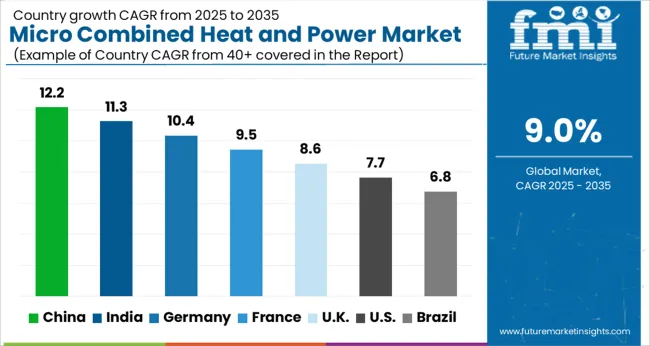
| Country | CAGR |
|---|---|
| China | 12.2% |
| India | 11.3% |
| Germany | 10.4% |
| France | 9.5% |
| UK | 8.6% |
| USA | 7.7% |
| Brazil | 6.8% |
The market is projected to expand due to increasing energy efficiency initiatives and decentralized power generation. China leads with 12.2%, driven by large-scale adoption in residential and commercial sectors. India follows at 11.3%, supported by government incentives and rising demand for distributed energy solutions. Germany achieves 10.4%, benefiting from strong integration in industrial and commercial facilities.
The United Kingdom records 8.6%, where investments in sustainable energy technologies promote market growth. The United States attains 7.7%, with steady deployment in residential and small-scale commercial applications. Together, these countries represent a dynamic mix of production, implementation, and innovation influencing the global micro combined heat and power market. This report includes insights on 40+ countries; the top markets are shown here for reference.
China’s market is projected to grow at a CAGR of 12.2% over the forecast period, driven by the increasing demand for decentralized energy systems, industrial efficiency improvements, and urban infrastructure modernization. Government initiatives promoting energy-efficient technologies and incentives for low-carbon solutions are stimulating adoption across industrial, commercial, and residential sectors.
Technological advancements focusing on smart grid integration, high-efficiency units, and compact designs are attracting industrial and residential consumers alike. Rising awareness of energy cost savings and environmental benefits further supports market expansion. Industry players are enhancing product portfolios to meet diversified energy needs, while partnerships and collaborations facilitate rapid deployment in tier-1 and tier-2 cities.
India is anticipated to expand at a CAGR of 11.3%, underpinned by industrial growth, increasing electricity costs, and rising awareness of sustainable energy solutions. Implementation of cogeneration systems in commercial and manufacturing sectors is growing rapidly, supported by favorable government policies and subsidies promoting renewable energy integration.
Technological innovations in compact, high-efficiency units are facilitating deployment in urban and semi-urban areas. Industrial sectors are prioritizing energy cost reduction and carbon footprint minimization, while residential users are adopting micro CHP solutions for reliable heating and electricity generation. Market growth is further driven by collaborations among equipment manufacturers and energy service providers, enhancing service networks and maintenance efficiency.
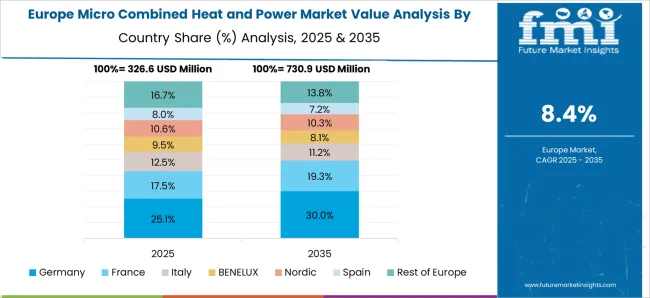
Germany is expected to grow at a CAGR of 10.4% due to stringent energy efficiency regulations, industrial cogeneration demands, and consumer preference for low-carbon solutions. The market is supported by government incentives for residential and commercial installations of energy-efficient CHP units. Technological advancements are focused on compact, high-performance systems suitable for integration with renewable energy sources and smart energy grids.
Growing awareness among businesses and homeowners regarding energy cost savings, reliability, and environmental benefits is accelerating adoption. The demand is particularly high in industrial manufacturing hubs and urban residential clusters. Strategic initiatives by market players, including partnerships and technology licensing, further contribute to market expansion.
The United Kingdom is forecasted to grow at a CAGR of 8.6%, driven by increased interest in energy-efficient heating solutions, reduced energy costs, and environmental considerations. Adoption is growing across residential, commercial, and light industrial applications.
Micro CHP units integrated with renewable energy sources and smart home energy management systems are gaining traction. Industry players are focusing on enhancing reliability, efficiency, and compact design to meet diverse consumer requirements. Government initiatives supporting low-carbon and energy-efficient technologies further promote market growth. Increasing partnerships among technology providers, energy companies, and service providers enable broader market penetration and improved maintenance support.

The United States is anticipated to grow at a CAGR of 7.7%, driven by increasing demand for energy-efficient and cost-saving solutions in commercial and industrial sectors. Market adoption is supported by technological innovations in compact, high-performance micro CHP units. Integration with renewable energy and smart energy systems is enhancing reliability and operational efficiency. Government policies and incentives promoting clean energy solutions further encourage market penetration.
Commercial establishments and residential consumers are increasingly adopting micro CHP solutions to reduce electricity and heating costs while supporting environmental sustainability. Strategic collaborations among equipment manufacturers, energy service providers, and technology innovators are expanding service networks, product accessibility, and maintenance capabilities.
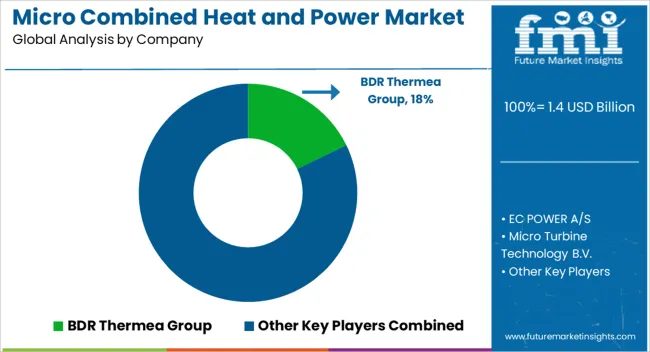
The market is characterized by technological innovation and a focus on energy efficiency, driven by companies that integrate electricity generation with heating solutions. BDR Thermea Group, Viessmann, and Vaillant Group are notable leaders, offering advanced residential and commercial micro-CHP units designed to optimize fuel consumption while reducing carbon emissions.
YANMAR HOLDINGS Co. and AISIN CORPORATION provide compact, high-efficiency solutions tailored for urban and industrial applications, emphasizing reliability and long operational life. EC POWER A/S, Micro Turbine Technology B.V., and 2G Energy AG specialize in micro-turbine and fuel cell-based CHP systems, supporting distributed energy models and enabling decentralized power generation. TEDOM a.s. contributes to the market with modular, scalable solutions suitable for various industrial and commercial needs. Siemens and Veolia leverage their global expertise in energy management and system integration, ensuring the adoption of smart, connected CHP solutions.
Axiom Energy Group, LLC complements the market landscape by offering innovative energy management systems that enhance operational efficiency and system monitoring. Collectively, these players drive market growth by promoting sustainability, regulatory compliance, and cost-effective energy solutions across residential, commercial, and industrial segments, addressing the rising demand for decentralized and environmentally conscious energy generation.
| Item | Value |
|---|---|
| Quantitative Units | USD 1.4 Billion |
| Capacity | 2kW, 2 kW to ≤ 10 kW, and > 10 kW to ≤ 50 kW |
| Fuel | Natural Gas & LPG, Coal, Renewable Resources, Oil, and Others |
| Prime Mover | Internal Combustion Engine, Stirling Engine, Fuel Cell, and Others |
| Application | Residential and Commercial |
| Regions Covered | North America, Europe, Asia-Pacific, Latin America, Middle East & Africa |
| Country Covered | United States, Canada, Germany, France, United Kingdom, China, Japan, India, Brazil, South Africa |
| Key Companies Profiled | BDR Thermea Group, EC POWER A/S, Micro Turbine Technology B.V., 2G Energy AG, TEDOM a.s., YANMAR HOLDINGS Co., Viessmann, AISIN CORPORATION, Veolia, Vaillant Group, Siemens, and Axiom Energy Group, LLC |
| Additional Attributes | Dollar sales by system type and application, demand dynamics across residential, commercial, and small industrial sectors, regional trends in decentralized energy adoption, innovation in efficiency, fuel flexibility, and compact design, environmental impact of emissions and resource consumption, and emerging use cases in smart homes, district heating, and distributed energy systems. |
The global micro combined heat and power market is estimated to be valued at USD 1.4 billion in 2025.
The market size for the micro combined heat and power market is projected to reach USD 3.3 billion by 2035.
The micro combined heat and power market is expected to grow at a 9.0% CAGR between 2025 and 2035.
The key product types in micro combined heat and power market are 2kw, 2 kw to ≤ 10 kw and > 10 kw to ≤ 50 kw.
In terms of fuel, natural gas & lpg segment to command 58.4% share in the micro combined heat and power market in 2025.






Full Research Suite comprises of:
Market outlook & trends analysis
Interviews & case studies
Strategic recommendations
Vendor profiles & capabilities analysis
5-year forecasts
8 regions and 60+ country-level data splits
Market segment data splits
12 months of continuous data updates
DELIVERED AS:
PDF EXCEL ONLINE
Micro-Dosing Sachet Fillers Market Analysis - Size and Share Forecast Outlook 2025 to 2035
Microbial Growth Monitoring System Market Size and Share Forecast Outlook 2025 to 2035
Micro Hotel Market Forecast and Outlook 2025 to 2035
Microwave Source Market Size and Share Forecast Outlook 2025 to 2035
Micro-energy Harvesting System Market Size and Share Forecast Outlook 2025 to 2035
Micro CHP Market Size and Share Forecast Outlook 2025 to 2035
Micro Irrigation System Market Size and Share Forecast Outlook 2025 to 2035
Micro Flute Paper Market Size and Share Forecast Outlook 2025 to 2035
Microcrystalline Cellulose Market Size and Share Forecast Outlook 2025 to 2035
Micro Balances Market Size and Share Forecast Outlook 2025 to 2035
Micro Perforated Films Packaging Market Size and Share Forecast Outlook 2025 to 2035
Microbial Coagulants Market Size and Share Forecast Outlook 2025 to 2035
Microserver IC Market Size and Share Forecast Outlook 2025 to 2035
Microsclerotherapy Treatment Market Size and Share Forecast Outlook 2025 to 2035
MicroLED Photoluminescence Inspection System Market Size and Share Forecast Outlook 2025 to 2035
Micro-Scale VFFS Modules Market Analysis - Size and Share Forecast Outlook 2025 to 2035
Microscope Digital Camera Market Size and Share Forecast Outlook 2025 to 2035
Micro Guide Catheter Market Size and Share Forecast Outlook 2025 to 2035
Micro Perforation Machines Market Size and Share Forecast Outlook 2025 to 2035
Micro Battery Market Size and Share Forecast Outlook 2025 to 2035

Thank you!
You will receive an email from our Business Development Manager. Please be sure to check your SPAM/JUNK folder too.
Chat With
MaRIA